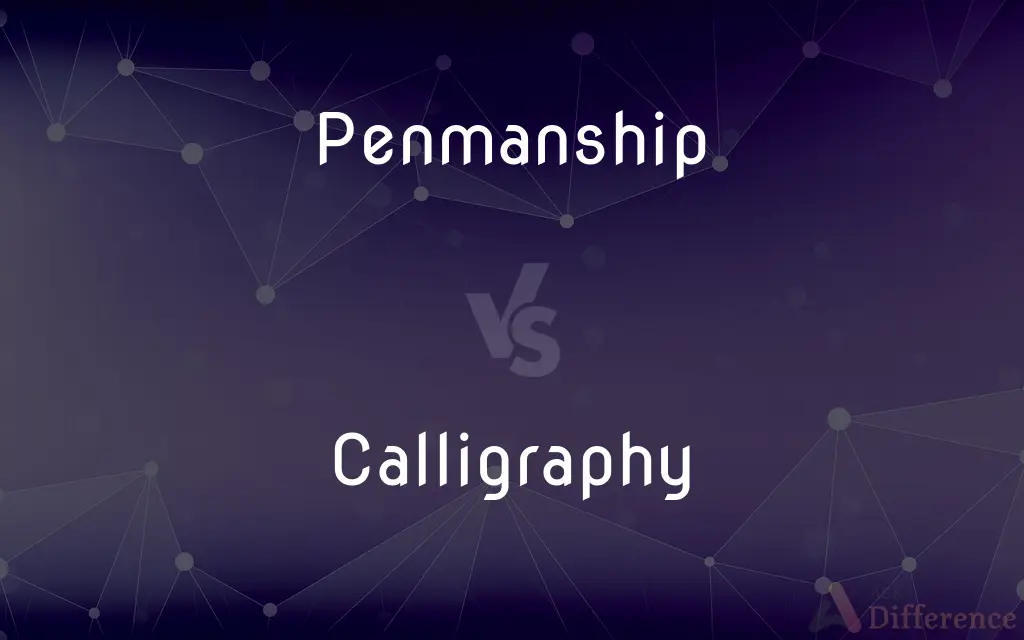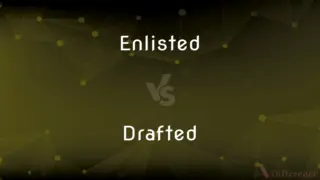Penmanship vs. Calligraphy — What's the Difference?
By Tayyaba Rehman & Fiza Rafique — Updated on April 3, 2024
Penmanship refers to the skill of handwriting, emphasizing legibility and neatness, while calligraphy is an art form that focuses on beautiful and stylized writing, often with decorative flourishes.

Difference Between Penmanship and Calligraphy
Table of Contents
ADVERTISEMENT
Key Differences
Penmanship is the technique or skill of writing by hand in a readable and aesthetically pleasing manner. It's primarily concerned with clarity, uniformity, and speed, suitable for everyday writing tasks. Calligraphy, on the other hand, is the art of beautiful writing, involving specific strokes, movements, and a sense of creativity and style that transcends mere legibility.
While penmanship is taught in educational settings as a basic skill, focusing on the practical aspects of writing, calligraphy is often pursued as a hobby or professional art form. It involves learning historical scripts, experimenting with ink and brush types, and mastering the aesthetic aspects of letterforms. Calligraphy is less about the content of the writing and more about the presentation and artistic expression.
Good penmanship is valued for its role in clear communication, especially in contexts where handwritten notes and documents are prevalent. It reflects the writer's discipline and attention to detail. Conversely, calligraphy is appreciated for its beauty and artistic value, often used in formal invitations, logos, and artwork where visual impact is important.
The tools and materials used in penmanship and calligraphy also differ. Penmanship can be practiced with any basic writing instrument, like a pencil or ballpoint pen, on standard paper. Calligraphy, however, often requires specialized tools such as fountain pens, dip pens, ink brushes, and high-quality paper to achieve the desired artistic effects.
The mastery of both skills requires practice, but the learning paths diverge significantly. Penmanship improvement focuses on consistency, neatness, and fluency, beneficial for everyday writing. Calligraphy delves into the artistic and historical aspects of writing, offering a creative outlet and a way to preserve ancient writing traditions.
ADVERTISEMENT
Comparison Chart
Definition
The art or skill of writing by hand in a legible and neat manner.
The art of producing decorative handwriting or lettering with a pen or brush.
Focus
Legibility and neatness.
Artistic expression and beauty.
Purpose
Practical writing.
Artistic and decorative writing.
Tools
Basic writing instruments (pencils, ballpoint pens).
Specialized tools (fountain pens, dip pens, ink brushes).
Learning Objectives
Improve readability and speed.
Master artistic styles and embellishments.
Compare with Definitions
Penmanship
The skill of writing by hand in a clear and concise manner.
Her excellent penmanship made her notes easy to read.
Calligraphy
The art of creating beautiful symbols by hand.
She took up calligraphy to make personalized greeting cards.
Penmanship
Practice of maintaining uniformity and neatness in handwriting.
Good penmanship is essential for handwritten exams.
Calligraphy
The technique of decorative handwriting or lettering with a pen or brush.
Calligraphy classes teach various historical scripts.
Penmanship
The act of writing with an emphasis on legibility.
Penmanship exercises help improve handwriting clarity.
Calligraphy
A form of visual art related to writing.
Modern calligraphy blends traditional techniques with contemporary designs.
Penmanship
The quality of one's handwriting.
His penmanship improved significantly after practicing daily.
Calligraphy
An artistic practice focused on stylized letter forms.
His calligraphy work was featured in an art exhibition.
Penmanship
An individual's style of writing by hand.
You can tell a lot about a person by their penmanship.
Calligraphy
The craft of expressing text in an expressive, harmonious, and skillful manner.
Wedding invitations often feature calligraphy for an elegant touch.
Penmanship
Penmanship is the technique of writing with the hand using a writing instrument. Today, this is most commonly done with a pen, or pencil, but throughout history has included many different implements.
Calligraphy
Calligraphy (from Greek: καλλιγραφία) is a visual art related to writing. It is the design and execution of lettering with a pen, ink brush, or other writing instrument.
Penmanship
The art, skill, style, or manner of handwriting.
Calligraphy
The art of decorative handwriting.
Penmanship
Synonym of handwriting, one's own style of writing.
Calligraphy
Works in decorative handwriting considered as a group.
Penmanship
Synonym of calligraphy, the art of beautiful writing.
Calligraphy
Handwriting.
Penmanship
The use of the pen in writing; the art of writing; style or manner of writing; chirography; as, good or bad penmanship.
Calligraphy
(uncountable) The art or practice of writing letters and words in a decorative style; the letters and words so written.
Penmanship
Beautiful handwriting
Calligraphy
(countable) Any such style of decorative writing.
Calligraphy
(countable) A document written in decorative style.
Calligraphy
Fair or elegant penmanship.
Calligraphy
Beautiful handwriting
Common Curiosities
How does one choose between learning penmanship and calligraphy?
It depends on the individual's goals: practical writing improvement or artistic expression.
Can calligraphy be self-taught?
Many resources are available for self-learning, though guidance can refine techniques and styles.
Is calligraphy harder to learn than penmanship?
Calligraphy can be more challenging due to its artistic aspects and the mastery of specialized tools.
Are digital tools relevant for calligraphy and penmanship?
Digital tools can simulate calligraphic styles and help practice penmanship, though traditional methods are preferred for authenticity.
How do penmanship and calligraphy contribute to historical studies?
They offer insights into cultural and technological developments through handwriting styles and materials used.
How do cultural differences influence calligraphy?
Different cultures have unique scripts and traditions, significantly influencing calligraphic styles and techniques.
Can good penmanship improve calligraphy skills?
Yes, a solid foundation in penmanship can provide the discipline and control beneficial for learning calligraphy.
How often should one practice calligraphy to see improvement?
Regular practice, even just a few minutes daily, can lead to noticeable improvement over time.
Is there a right age to start learning calligraphy?
There's no specific age; it can be learned and enjoyed at any stage of life.
What are the benefits of good penmanship?
It facilitates clear communication, reflects professionalism, and can improve cognitive connections during note-taking.
Can practicing calligraphy be therapeutic?
Yes, many find the focused and repetitive nature of calligraphy to be a form of mindfulness and stress relief.
What is the significance of calligraphy in the digital age?
It preserves traditional art forms, adds personal touches to digital media, and contrasts with the impersonality of typed text.
Is penmanship still taught in schools?
Yes, though the emphasis varies by curriculum and region, basic penmanship is generally taught.
What impact does the choice of paper have on penmanship and calligraphy?
The right paper can enhance ink flow and prevent bleeding, improving the overall quality of writing and art.
Can excellent penmanship or calligraphy skills lead to career opportunities?
Yes, they can open doors in fields like graphic design, typography, event planning, and art education.
Share Your Discovery

Previous Comparison
Cow vs. Stirk
Next Comparison
Enlisted vs. DraftedAuthor Spotlight
Written by
Tayyaba RehmanTayyaba Rehman is a distinguished writer, currently serving as a primary contributor to askdifference.com. As a researcher in semantics and etymology, Tayyaba's passion for the complexity of languages and their distinctions has found a perfect home on the platform. Tayyaba delves into the intricacies of language, distinguishing between commonly confused words and phrases, thereby providing clarity for readers worldwide.
Co-written by
Fiza RafiqueFiza Rafique is a skilled content writer at AskDifference.com, where she meticulously refines and enhances written pieces. Drawing from her vast editorial expertise, Fiza ensures clarity, accuracy, and precision in every article. Passionate about language, she continually seeks to elevate the quality of content for readers worldwide.
















































